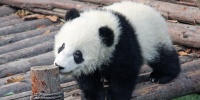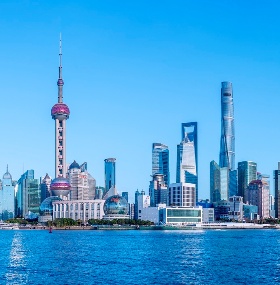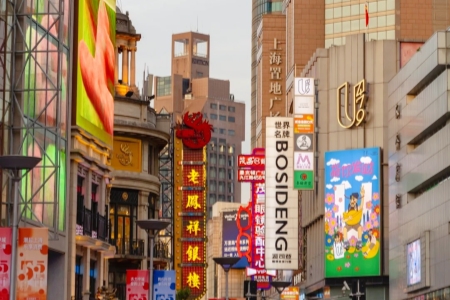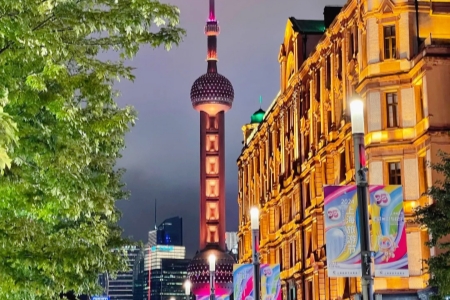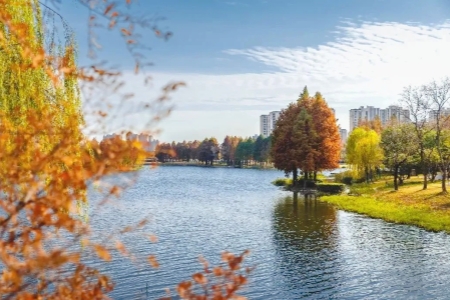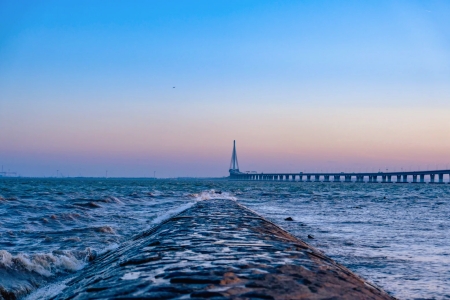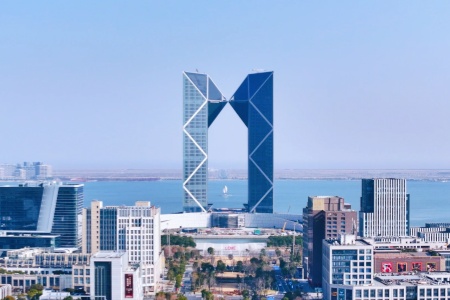Must-see attractions in Western Sichuan
1. Zheduo Mountain
Zheduo Mountain is known as the "First Pass of Khamba" because since the Erlang Mountain Tunnel was opened, Zheduo Mountain has become the first challenging mountain on the Sichuan-Tibet line. Zheduo Mountain is an important geographical dividing line. Only after passing Zheduo Mountain can you enter the real Tibetan place. The winding mountain road of Zheduo Mountain is truly "nine bends and eighteen turns". When encountering downhill sections, you must pay attention to slow down and drive slowly to avoid accidents. After passing the 4298-meter pass here, National Highway 318 goes down all the way and enters the photographer's paradise-Xinduqiao.
2. Kangding Mugecuo
Mugecuo, also known as "Wild Man Lake" and "Dahaizi", is one of the largest alpine lakes in northwest Sichuan. It is 3,700 meters above sea level, surrounded by mountains and forests, and dozens of small lakes such as the Red Sea, the Black Sea, and the White Sea, like stars holding the moon. Mugecuo has four seasons of scenery in one day, and the sky is different in the morning and evening. In the early morning, the fog locks the sea surface, and the silver dragon-like clouds roll on the water surface, creating a moving landscape of "double fog falling into the sea". When the breeze points to the face in the afternoon, the sea surface "has three feet of waves without wind, and thousands of piles of snow are rolling". In the afternoon, the beach around the lake presents a dazzling golden color. When the weather is fine, looking at the snow-capped mountains in the distance, you will feel like a holy fairyland.
【Ticket Price】:
Peak season: RMB 105 (Monday to Sunday, April 1st - November 30th)
Off-season: RMB 75 (Monday to Sunday, December 1st - March 31st of the following year)
3. Xinduqiao
Xinduqiao is about 3,300 meters above sea level and does not have any outstanding landmarks, but the more than 10 kilometers along the route are known as the "Photographer's Corridor". It is located at the fork of the south and north lines of National Highway 318; the mountains are rolling, with Tibetan villages scattered among them, and the plain scenery in western Sichuan is beautiful. Tibetan houses are very distinctive, with spacious white-walled courtyards and vermilion lacquered doors. The window eaves are painted with red, black, white and other colors to represent the sun, moon or triangular patterns that symbolize a prosperous population and a good harvest. The scenery of Xinduqiao is along the way, especially the section from Zheduo Mountain to Xinduqiao and the section from Xinduqiao to Tagong.
【Ticket Price】: Free
4. Yala Snow Mountain
Yala Snow Mountain is one of the four sacred mountains in Tibet. The top of the mountain is covered with snow all year round. It is not suitable for climbing and can only be viewed from a distance.
5. Tagong Grassland
This is the pure pastoral grassland closest to Kangding. From late June to early August every year, it is the most beautiful and lively season of Tagong Grassland. If you are lucky, you can catch up with the grand traditional horse racing.
Wild flowers are in full bloom along the road of Tagong. Occasionally, tents with white background and blue patterns are set up casually on the green grass. There may be yaks, horses or sheep grazing leisurely in your sight, and your mood will become bright and casual.
Tagong Temple is an important part of Tagong Grassland. There are three mountain ranges behind the temple. There are many triangular or square flag formations composed of Mani prayer flags on the mountain. They are fluttering in the wind. Although the various colors have lost their former beauty in the wind and rain, it does not affect the piety of the Tibetans. It is said that the prayer flags are read by the wind to the ears of the Buddha. Those are the three sacred mountains of the Three Mountains of the Tibetan Buddhist Sect.
【Ticket Price】: 15 RMB cleaning fee
6. Danba Jiaju Tibetan Village
This is the essence of the beautiful Sichuan Provincial Road 205. It is the settlement area of the Muya Tibetans. The best way to play is to stay here for a while in the golden autumn season. You will be captured by the charming scenery. Walking between the characteristic Tibetan houses, staying in the prosperous poplar forest, watching the rushing river and suspended clouds, etc., let you find your childhood memories and fairy-tale beauty one by one.
7. Siguniang Mountain
Siguniang Mountain is the highest peak of the Qionglai Mountain System on the eastern edge of the Hengduan Mountains. It consists of four continuous peaks. From north to south, their heights are 6250 meters, 5664 meters, 5454 meters, and 5355 meters respectively. The altitude is very high and may cause altitude sickness. These four peaks are covered with ice and snow all year round, like four girls wearing white veils, standing one after another on the two Milky Ways of Changpinggou and Haizigou.
Siguniang Mountain has always been a paradise for hiking enthusiasts. From the mouth of Changpinggou to the mouth of Bipenggou, it is about 70 kilometers long. The canyon mountain road is rugged and narrow, and the waterfall streams melted from the icebergs flow slowly; and across the valley, there is a wide alpine meadow full of flowers, and the scenery is very soft. When you come to Siguniang Mountain, you can't miss the beautiful autumn scenery of Jiajinhaizi Lake and the Lama Temple with a history of more than 2,000 years. You must also go to Wolong to see the cute giant pandas along the way.
【Ticket price】:
1. Full price ticket for Shuangqiaogou: RMB 80; Full price ticket for Changpinggou: RMB 70; Full price ticket for Haizigou: RMB 60 (April 1st - November 30th, Monday to Sunday)
2. Full price ticket for Shuangqiaogou: RMB 50; Full price ticket for Changpinggou: RMB 50; Full price ticket for Haizigou: RMB 40 (December 1st - March 31st of the following year, Monday to Sunday)
3. Half price ticket: students, teenagers (7-18 years old), children over 1.2 meters, seniors aged 60-64 years old
4. Free ticket: seniors over 65 years old, children under 6 years old (including 6 years old)
【Sightseeing bus ticket】:
Shuangqiaogou: RMB 70/person; Changpinggou: RMB 20/person
【Opening hours】: 07:30-18:30 (February 18th - December 31st Monday-Sunday)
8. Hailuogou
Hailuogou is the closest place to Chengdu for glacier viewing, with low-altitude modern glaciers. In Hailuogou, you can get close to the glaciers, see red rocks, and soak in hot springs. The most wonderful thing in Hailuogou is to soak in hot springs in the ice and snow while watching the snowflakes fluttering.
【Ticket Price】:
1. Ticket + round-trip sightseeing bus: RMB 160 (Monday to Sunday, January 1st - December 31st)
2. Half-price ticket: children under 1.2m-1.4m in height; minors aged 6 (excluding 6 years old)-18 (including 18 years old); foreign tourists aged 60-64 with valid passports (during statutory holidays)
3. Free ticket: children under 1.2m (including 1.2m in height); children under 6 (including 6 years old); foreign tourists aged 60-64 with valid passports (non-statutory holidays)
【Tips】:
1. All customers who enjoy free ticket discounts need to pay an insurance premium of RMB 10 per person.
2. This scenic spot implements a non-differential ticket policy for Chinese and foreign tourists.
【Opening hours】: 07:00-15:00 (June 1-December 31, Monday-Sunday)
Departing from Chengdu, without retracing the same route.
Day1: Chengdu-Ya'an-Luding-Kangding-Xinduqiao
The first day's journey is about 400KM. Start from Chengdu in the morning, pass through Ya'an, cross the Erlangshan Tunnel to Luding, and visit the Red Army's capture of Luding Bridge in Luding. After arriving in Kangding, cross Zheduo Mountain to Xinduqiao. There are many bends in Zheduo Mountain, so you need to drive carefully. Zheduo Mountain is the first high altitude in the entire journey, and you may experience altitude sickness. Stay in Xinduqiao at night.
Tickets: Luding Bridge 10 RMB/person
Day2: Xinduqiao-Tagong-Bamei-Danba
The second day's journey is about 150KM. The most beautiful scenery in the entire journey is on this road. Get up in the morning to take photos at the most beautiful Ten-mile Corridor in Xinduqiao, then arrive at Tagong, worship Tagong Temple, feel the power of faith, watch the scenery of Tagong grassland, watch yaks grazing, prayer flags fluttering in the distance, and look at the Yala Snow Mountain in the distance. Then go to Bamei, watch the Stone Forest, and then go down the mountain along the river valley to Danba, visit the most beautiful Jiaju Tibetan Village, and stay in Jiaju Tibetan Village.
Tickets: Tagong grassland 10 RMB/person, Tagong Temple 20 RMB/person, Jiaju Tibetan Village 50 RMB/person
Day3: Danba-Mt. Siguniang-Mt. Balang-Mt. Wolong-Yingxiu-Chengdu
The third day's itinerary is about 330 kilometers. Get up early in the morning to take pictures of the early morning of Danba Jiaju Tibetan Village, then take a car to Rilong Town, and go to Maobiliang to see the panoramic view of Mt. Siguniang. After crossing Balang Mountain, the scenery of this section of the road is also very beautiful. Arrive in Wolong, visit Wolong Panda Garden, and watch this group of cute giant pandas. Finally, return to Chengdu from Yingxiu.
Best season to visit western Sichuan
The most beautiful season in western Sichuan is autumn. From mid-October to mid-November every year, the mountains and plains are golden and the scenery is gorgeous.
However, every season in western Sichuan has its own unique beauty. In spring, flowers bloom, in summer, the ground is green, in autumn, it reaches its peak, and in winter, you can go to western Sichuan to see the snow scenery. It should be noted that summer is the rainy season in western Sichuan. It is best to choose a sunny day to travel. In winter, there may be hidden ice on the road, so you need to be careful when driving.
Precautions for traveling in western Sichuan
1. The western Sichuan plateau is at a high altitude. Do not exercise vigorously. You may have altitude sickness such as headache and tinnitus when you first arrive at the plateau. These are all normal and you will gradually adapt.
2. The temperature difference in the plateau is large. You should pay attention to keeping warm and it is best to wear a hat.
3. Western Sichuan is mostly a minority area, so you should respect local customs.
4. The ultraviolet rays in the plateau are strong and it is easy to get sunburned. You need to do a good job of sun protection.
5. Many hotels and inns in western Sichuan do not have toiletries. It is recommended to bring your own.
Related Posts
Create Your Customized Trip
Take about 2 minutes to fill the form to tell us how you like to travel, and get a reply within 1 working day.
